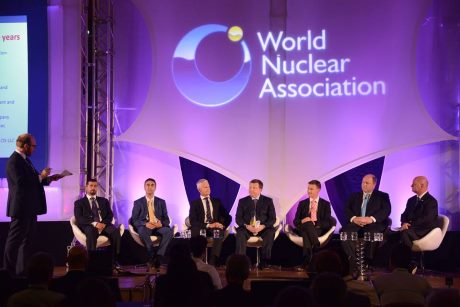In the 60th anniversary year of nuclear energy, leaders from the sector debated the investment model for future construction projects.
 |
| The leaders panel at the WNA Symposium (Image: WNA) |
The global financial crisis and the Fukushima Daiichi nuclear power plant accident together impacted the appetite among governments – the traditional investor in the industry – to put public money into projects to build new reactors. The result is that reactor vendors have had to take up the slack and put equity financing into a project in order to get their own technology built.
Speaking at the World Nuclear Association's 2014 Symposium in London, Danny Roderick, president and CEO of Westinghouse Electric Company, said this had meant a draw on finances away from research and development.
"The challenge for us being a technology company is that we have to tie up a significant amount of working capital into a project investment. That’s R&D money," Roderick said. "My only concern about where we are today is that, in this market, we continually see heavy pressures for equity investment and that really deprives the other capital markets that we need to be in to continue a really aggressive research program," he said. "That said, I don't believe it will be long term - as the market does grow what we’ll see is a return back to a normalized market where we are competing for the work based on its merits of technology, price and commercial terms, and not for the kind of equity we bring. But I am worried about the tying up of equity for a decade effectively that we could be using to develop new technology and to lay out new products. Today, we are active in ten countries and there are eight different models in those ten countries on how they have approached their new build. I'm hoping that will stabilize out over the next few years," he said.
Jay Wileman, senior vice president for nuclear plant projects and chief operating officer at GE Hitachi Nuclear Energy, said his company – another reactor technology provider – had put hundreds of millions of dollars into innovation. "When we do sign up for a large project, we do put a lot of our equity at risk. We need to find an appropriate model that lets everyone focus on where their core strengths are," Wileman said.
Mohamed Al Hammadi, CEO of Emirates Nuclear Energy Corporation, said the UAE started its new build program "from scratch" six years ago. The plants will largely be financed by the state, without the need for loans, but with some Korean equity partners.
"Market demand for nuclear has to be higher for it to become easier on the shoulders of the vendors," said Al Hammadi. "Today, demand is not big enough to generate enough cash flow for the utilities. To have a sustainable nuclear energy program for a new nuclear power nation – you need about four units. Less than two will not be enough to sustain the program," he said. "Every country will have a different financing structure model, but the key is that demand currently for reactors is low, which is why most of vendors are putting in some of the financing to create enough nuclear power plants, to make them bankable [assets]. But nuclear is not too expensive. The economics of it all make sense, which is why we aren’t buying one unit, but four," he said.
Kirill Komarov, deputy director general for international business at Rosatom, said that a vendor's ability to invest, a utility's readiness to invest, and some form of contribution from the government "are all important".
"The main point is the investment return. It is very difficult to manage all these elements which are very often separate – the opex, capex, cost of fuel, cost of reprocessing spent fuel, some of these decisions can be postponed - but if you want to invest you need to - as a minimum - predict the final result, which for me is the price of electricity," Komarov said.
Rosatom’s build-own-operate financing model for its Akkuyu nuclear power plant project in Turkey is underpinned by its agreement with Turkish Electricity Trade and Contract Corporation (Tetas). Tetas has guaranteed the purchase of 70% power generated from the first two units and 30% from the third and fourth units over a 15-year power purchase agreement.
“Maybe it is logical to create some consortium, but we should think very carefully about the investment return. If we can clarify this question, it is easy to make a decision [to invest],” Komarov said.
Researched and written
by World Nuclear News





_30199.jpg)
_72306.jpg)

_49562.jpg)





